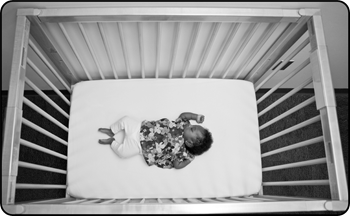Safe Sleep for Babies
Sleep-related deaths are one of the top causes of deaths for newborns until 1 year of age. This is called sudden unexpected infant death syndrome (SUIDs), formerly called SIDs.
Rules for Safe Sleep
Follow the ABCs of sleep and the safe sleep rules below to help prevent SUIDs.
- Alone – Do not put your baby in a bed with anyone else, including pets. Do not put blankets, toys, or pillows in their crib or bassinet.
- Back – Place your baby on their back to sleep. Do not put them to sleep on their side or tummy.
- Crib – Use a crib or bassinet with a firm, flat mattress and a fitted sheet. Do not use bumpers or attach anything to the crib.

For more information about safe sleep and home safety, go to Ohio Better Birth Outcomes.
Where Baby Sleeps
Babies MUST have their own safe sleep space. Pick a standard crib, bassinet, or playpen (Pack-n-Play®). If you get something used or secondhand, make sure it follows the rules below.
ALWAYS use a firm mattress and a tightly fitted sheet over the mattress.
- Cribs
- Crib rails must be no more than 2 and 3/8 inches (6 cm) apart. This is about the size of a dollar bill or soda can (Picture 2).
- NEVER use a crib with side rails that drop down.
- NEVER use a painted crib. Babies like to chew on crib bars and will eat paint flakes.
- Bassinets
- Usually comes with a firm mattress.
- Can NOT be used once your baby can roll over on their own.
- Playpen (Pack-n-Play®)
- Always make sure to lock the playpen sides securely.
- Use the mattress that comes with your playpen. Do NOT buy a mattress topper for your playpen.
How to Put Baby to Sleep
Your baby is safest when sleeping on their back.
- Do NOT put your baby to sleep on their side. Even if your baby spits up, they’re safest on their back.
- If your baby changes positions in their sleep, it’s okay to let them stay in that position.
- Do NOT let your baby sleep in a car seat, swing, Boppy Pillow®, or baby lounger. If they fall asleep while in them, move them to their safe sleep place.
DO
- Share the room with your baby. It's comforting for both baby and their caregivers to be close to each other.
- Decorate your baby's room as you choose. Leave baby's sleep space empty.
- Keep cords from blinds or curtains away from their sleep spot.
DON'T
- NEVER shre your bed with your baby. Do not let adults, other children, or pets share a sleep spot with your baby.
- NEVER let anyone smoke around your baby. Even with a window open, smoking in the room as they sleep increases the chances of SUIDS.
Room Temperature
Keep the room your baby sleeps in at a comfortable temperature. If you’re comfortable in the room, your baby will be too.
- If the room is cold:
- Use a wearable blanket (SleepSack®) to keep your baby warm. Do NOT put a regular blanket on them while they sleep.
- Layer your baby with a Onesie® under pajamas, or dress them in warmer pajamas.
- Do NOT put hats or hoods on your baby while they sleep. These can fall onto their face and block breathing.
- If the room is warm:
- Do NOT overheat your baby. Overheating may cause problems with breathing and waking up. Do NOT over-bundle your baby. They should not feel hot to the touch.
- Babies only need one more layer of clothing than an adult in the same room.
- Products that claim to lower (reduce) the risk of SUIDs.
- Non-prescribed home monitors while your baby sleeps.
- Weighted blankets or weighted sleep sacks.
- Breast/chest feeding has been shown to decrease the risk of SUIDs. You may feed your baby in bed with you, but always remember to put them back in their ABC safe sleep place when you are done. Set an alarm in case you fall asleep.
- Using a pacifier can help prevent SUIDs.
- Offer a clean, dry pacifier to your baby at sleep times.
- If the pacifier falls out while your baby is sleeping, you don’t need to put it back.
- Do NOT force your baby to use a pacifier.
- Do NOT clip a pacifier to your baby’s clothing, blankets, or stuffed animal
- Do NOT use anything to hold (prop) the pacifier against your baby’s mouth.
- ALWAYS stay with your baby and watch them while they do tummy time.
- ONLY do tummy time when your baby is awake. If your baby falls asleep during tummy time, move them to their back.
Warnings for Common Items in Stores
Some items sold in stores to use while your baby sleeps have NOT been tested for safety. Do NOT use:
Other Ways to Prevent SUIDs
Tummy Time
Tummy time lowers the chance of getting flat spots or bald spots on your baby’s head. It helps develop motor skills too.
Skin-to-Skin
If your baby naps on you while doing skin-to-skin, be sure to stay awake. This time can be very relaxing, so make sure to set an alarm in case you fall asleep too.
Helping Hands™ Patient Education Materials
Helping Hands™ are easy-to-read guides about different illnesses, therapies, surgeries, and more. They’re created by the Patient Education team at Nationwide Children’s Hospital and are reviewed and approved by clinical staff, like nurses, doctors, pharmacists, and psychologists. Nationwide Children's Hospital is not responsible for misuse of information in patient education materials, including Helping Hands.
HH-IV-69 | ©1995, revised 2025, Nationwide Children’s Hospital
